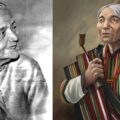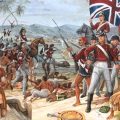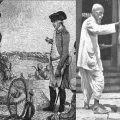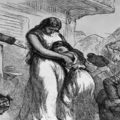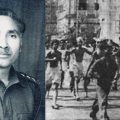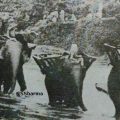Account of How Pasalthas in Lushai Hills of Mizoram Resisted British Rule
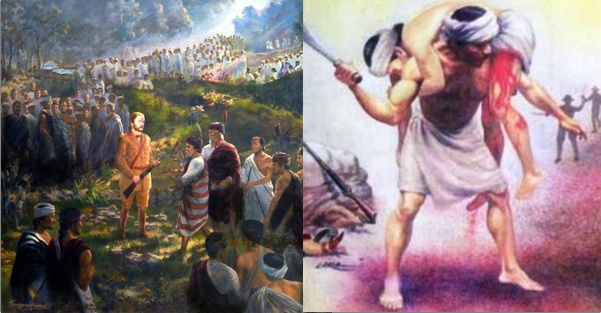
After the Battle of Plassey in 1757, the colonial occupation of Bengal was complete. The British were establishing their authority through either territorial annexation or forcible military occupation of one province after the other in Poorvottar Bharat. Prior to the arrival of the British in the Lushai hills (today’s Mizoram, earlier known as the Zo country), the people lived in a conglomeration of independent units (villages) consisting of 50-300 families under the control of a hereditary chief called Lal, on whom all power of land and people was vested. The livelihoods of the people were dependent upon agriculture, largely shifting cultivation, and hunting for meat.
The institution of Chieftainship was deeply rooted in the traditional society of the Lushais. It was a vital constituent of their political life. Regarding the origins of this institution, it is presumed that in the beginning, the privilege to govern the people was bestowed on those persons who wielded the power and the capability to command a certain group of individuals and repulse any onslaught by their enemies. It is thus apparent that those persons who had the capability and flair to gather and organise a competent militia eventually became the chief (Lal). Initially, chieftainship among the Lushais was strongly fought for; however, with the passage of time, it became hereditary.
Each village was an independent entity, ruled over by its own Lal who had sovereign power over his subjects. After the British occupation of Bengal, the Lals were arbitrarily stripped of their political powers, e.g. they could no longer wage wars, award capital punishments, decide upon making their sons the next chiefs, and collect taxes and tributes of various kinds, etc. Having crushed the powerful rebellion against its rule in India in 1857, the British power was at its peak in the 1860s. The administration therefore took vigorous steps to consolidate their hold over the Indian Empire.
The imperial superpower had traversed many tortuous terrains earlier as well. With their vast experience, the nature of the geography was hardly an obstacle when they entered the Lushai hills. But, it was the uncompromisingly independent nature of the Lushais under the able leadership of their Lals which, in fact, posed a greater hurdle in the way of accomplishment of the colonial designs. Earlier, in dealing with the different groups and communities of people living in the inhospitable hilly regions, the British were successful in some areas using their ‘carrot and stick’ policy. They first crushed them with their military might and granted them rewards for cooperating with them.
However, to the utter surprise and dismay of the colonial power, these policies bore little or almost no fruit in case of the frontier ‘hill tribes’ of Poorvottar Bharat. The Lushai chiefs of various clans living between the Run and Tiau rivers in the Chin Hills of Myanmar, used to undertake regular retaliatory expeditions to save their territories from British incursions. The arrival of the British in this region brought about significant changes in the social, political, cultural and religious aspects of the people’s lives. This transformation affected the Lushai society at large, which greatly embittered the chiefs and the common people alike.
Coming of the Christian Missionaries
As it was true for other places, the colonial policy of divide and rule achieved considerable success in the Lushai hills too, and eventually paved the way for Christian Missions. The latter followed on the heels of the British conquest to win over the Lushai Hills ‘for God and Empire’. The idea gradually began to develop that everything associated with the traditional religion and culture of the Lushai society was pagan and profane, hence not fit to be followed anymore by the new converts to Christianity. There was a planned destruction of the traditional knowledge systems of different communities through organised crime at the behest of Western colonialism and Christianity.
Colonial officers like J. Shakespear, A.G. McCall, etc. and Western missionaries like J.H. Lorrain, J.M. Llyod, Lewis E. Mendus, etc. held a Eurocentric, pre-determined Christian theological view in interpreting the traditional religion of the Lushais and the associated beliefs and practices. They described it as “crude animism” in their different writings on the Lushais. E.B. Taylor, a 19th century anthropologist, defined ‘animism’ as a doctrine of ‘Spiritual Beings’. The different cultural and spiritual aspects underlying these beliefs were either left undefined or mis-interpreted by the colonial rulers.
Decline of Traditional Belief Systems and Institutions
Most importantly, with the arrival of Christianity, the traditional institution of the Lushais called the zawlbuk (bachelors’ dormitories/bachelors’ quarters, commonly understood as a traditional Mizo educational institution) witnessed a gradual decline. In the words of Lalbiak Thanga, zawlbuk literally means ‘a big house built for young men to sleep together and keep a vigil at night against enemies’. The zawlbuk was a social welfare institution entrusted with the responsibility of maintaining peace and security in the village. It served as sleeping quarters and a recreational centre for unmarried as well as young married men.
The zawlbuk imparted training, both mental and physical, and discipline to the young boys. It also served as an inn for guests. Similar to a gurukulam, in the zawlbuk too, young men learned the techniques of warfare and fighting, wrestling, singing, traditional arts and handicrafts, stories of bravery, valour and all other essential customs and etiquettes deemed worthwhile for leading a physically and mentally satisfying life, and on how to conduct oneself among others in the society. Except the children who were below ten years of age, all unmarried males in the village came under the discipline of the zawlbuk, their lives being almost completely shaped according to the practices and conventions prevailing therein. Here, young boys had to serve and obey their elders, besides being associated with agriculture and other social activities.
The zawlbuks thus helped instil the spirit of service to the community among men from a very young age. It was the nerve centre of the pre-Christian Lushai society for it played an indispensable role in training the youth to become responsible adult members. In other words, as a powerful social and community institution, the zawlbuk exercised a great sway in establishing social norms and customs among the Lushais before the arrival of Christianity. The new education system introduced by the missionaries with the support of the colonial administration prevented many boys from staying in the zawlbuk for a long period of time. The local students who were educated in the mission schools and went back to their villages, began narrating to their friends what they learnt in these schools.
Capitalising on these, the missions started schools in the villages employing the students who had already passed out from the schools at either Aijal (Aizawl) or Lunglei. In a way, education was used by the Christian missions as an essential means to consolidate their social base and win “souls”, thereby achieving the goal of proselytisation among the non-Christian populace prior to the preaching of the Gospel. Where there was already a school run by the Christian missions, the missionaries usually organised a Sunday school in which stories from the Bible were taught. Popularly known as Sande Sikul, these were started from almost the beginning of the Christian missions in the Lushai hills since the 1890s.
It was later in 1924-28 that N.E. Parry, the then Superintendent of the Lushai hills wrote that in those villages where there were zawlbuks in existence, the people were comparatively better disciplined, more industrious, and expert hunters than in the villages where there were none. The British Government realized during the very early years of their rule that the institution of the zawlbuk must come to an end so as to further their political and religious agenda of proselytsation. Several such zawlbuks were burnt during the British-led military expeditions of 1888-91. Copies of the Mizo Ramayana that were kept in these zawlbuks also met the same fate. Eventually, the zawlbuk faded away, never again to be resurrected into its original form.
It was the then Governor of Assam, Sir Bamfield Fuller, who played an important role in handing over the education system of the zawlbuks in the Lushai hills to the missionaries. This admittedly changed the landscape of the Lushai society forever. The missionaries preached that the moral teachings and ethical principles of Christianity were already well-incorporated into the Lushai religious pantheon, and that if the newly-converted Christians among the Lushais observed the rules of the Church, their souls would be saved from burning in hell. The observance of these rules was declared by the Church as a means for attaining salvation. This was a vast change in the traditional beliefs and practices of the hill people, which was not accepted and welcomed by them at ease.
Beginning of the Conflict
Gradually, the Lushai traditional beliefs and practices were distorted by Christianity to establish a new set of doctrines and beliefs. Many social and cultural elements of the Lushai society were either modified or transformed and then reinterpreted by the missionaries with completely new meanings. The moral and ethical principles of the traditional religious beliefs of the Lushais now came to be redefined in the light of the Gospel. Over and above all these, the British officials imposed forced labour and house tax on every village and its people. This policy was met with fierce resistance from the Lals. Successive expeditions now took place from the Lushai hills on the British camps.
A lesser-known freedom fighter, Pasaltha Khuangchera, played a pivotal role in these expeditions. Fed up with the British demand for the payment of taxes, the Chieftainness of Denlung Ropuiliani, had remarked, “It is for the Pasalthas (brave warriors) to settle the matter.” The Pasalthas soon became a constant source of menace to the legitimacy of the colonial state. Their fight was driven by the demands of political autonomy as much as it was about defending their people by safeguarding their religious belief systems from “digestion” into a foreign faith. In fact, it was because of the valiant leadership of Pasalthas like Khuangchera that the Lushais were able to fight back the British army as it began its invasion.
Who was a Pasaltha?
It needs to be mentioned here that the word Pasaltha in the Mizo language implies a hero, although not in the modern sense of the term ‘hero’. It also means hunter who is equally a fighter. The spirit of Tlawmngaihna, a term used to denote the Lushai “code of morals” before the coming of Christianity, was a highly prized virtue that found expression in the lives of the Lushai heroes or Pasalthas. In the words of Lalthanliana, “the Pasaltha is a brave man, not simply enabling the village and its inhabitants to feel safe but the one who was imbued with Mizo tlawmngaihna.” Tlawmngaihna is a traditional virtue, an ethno-moralistic concept/code of conduct which encapsulated the Lushai society in its entirety. It enjoined a person to be selfless and self-sacrificing, to be helpful towards others, and also to be persevering and hard-working.
Kipgen defines Pasaltha as “a brave and manly person” who had proven his integrity of character by deeds of Tlawmngaihna. Such persons were revered and respected not only in the zawlbuk but also by the Lals of all other villages and their people. They looked upto him and honoured him in times of festivals as well. All the prerequisites of training for becoming a Pasaltha were received in the zawlbuk. The Pasaltha was an apt personification of the Lushai passion to safeguard their ways of living, dignity and honour. He always carried a long sword by his side, which was a mark of his sharp hunting skills and his responsibility as the protector of his village, its land and people. The credit and honour for the Pasaltha was symbolised by a special huge mug (usually made from bison horn) of zu no pui (rice beer) called Taima zu no or Huai zu no, that was offered to him by the Lal on the occasion of ceremonies and feasts.
In the traditional Lushai society, there were many persons who were regarded as Pasaltha or notable and successful hunters. They were accorded a special status for being the protectors and saviours of the village and their community. According to James Dokhuma, “The Pasaltha is not only a skilled hunter but also the one who is claimed to be famous for his prowess in taking heads of the enemies.” In fact, a Pasaltha usually brought several captives, numbering around ten. This also depended to a large extent upon the bravery and strength of the Pasaltha. Undoubtedly, the roles of the Pasalthas were far more conspicuous than others in the pre-Christian Lushai society. Its egalitarian character can be understood from the fact that any commoner could attain the status of a Pasaltha by dint of his bravery and service to the society. It was therefore a non-hereditary position.
Because of their daring, fearless and undaunted spirit, the Pasalthas were the pillars of strength for their community. They helped the poor and the sick, the destitute and the downtrodden in times of their need. The title Pasaltha itself was a mark of honorary dignity in recognition of the services rendered to the society. The Tribal Institute, Art and Culture Department, Government of Mizoram, has listed more than 24 ‘Mizo Heroes’ who were mostly active during the pre-colonial period and upto the first decade of the colonial administration of the Lushai hills, prior to the coming of the Christian missionaries. In most of the writings, no distinctions were made between the Pasaltha, warrior and tlawmngaihna or huaisen. If and when a man was successful in his mission of defeating the enemy or taming wild animals, he gradually became famous as Pasaltha not only within the village but also beyond his neighbour’s villages.
When a Pasaltha successfully saved the lives of his chiefs or elders, he was often rewarded in kind. He was someone who travelled to far-off lands to annihilate enemies, and brought home their heads. He was held in high esteem by all the village households, especially women. Apart from fighting enemies, hunting of wild animals was one of the main goals of the Pasalthas. The Pasaltha would sing a local Lushai song called Hlado after a successful hunt, proudly proclaiming his brave deeds at the entry point of the village. Another type of song called Bawhhla was sung by him from a distance at a very high pitch while coming back home with the heads of the slain enemies.
In the pre-colonial Lushai society, it was a common practice amongst parents that upon giving birth to a baby boy, the said baby was usually blessed to be a ‘great hunter and warrior’. Right from his childhood, the male child was imbibed with the traditional virtue of taking the enemy upon himself as one of his social obligations. It was the custom in every village household to let the newborn male baby hold a chem (a Mizo knife/dao), to convey the message that the future belonged to him and that he would also become resourceful to the society. The main objective was to kill as many wild animals and enemies as possible and especially bring back home their heads. In this way, he would be recognised as mi huaisen, meaning a ‘brave hero’. As a defender of the society, the Pasalthas were the symbols of security and social justice.
Khuangchera – The Most Adored Among all Pasalthas
One of the greatest heroes of the Mizos, Khuangchera was born in 1850 at the village Parvatui, which was then under the Chieftainship of Lianphunga. He later moved to the villages of Kanghmun and Reiek near present-day Aizawl. Reiek was then ruled by Sailianpuia, a chief from the Sailo clan of the Lushais. Khuangchera was gentle, brave and fearless, and was deeply concerned about the welfare of his people. As a child, Khuangchera was blessed with extraordinary physical strength. By virtue of his selfless and self-sacrificing qualities of bravery and righteousness, he was quickly able to win over the hearts of his people. He was also a reformer of the society in which he lived.
While Khuangchera was the leader of the youths of Parvatui village, he took many important steps to reform their character and also taught them the importance of being self-dependent. It is said that there was not a single incidence of elder youths meting out ill-treatment to the younger ones in Parvatui village during the lifetime of Khuangchera. He soon became a popular figure and a beloved leader of Parvatui. His life was a source of inspiration, a role-model for the people. In due course of time, Khuangchera’s services to the community became indispensable, so much so that the chief Lianphunga used to mention his name whenever he was in distress or whenever he sensed any danger looming around his territory.
Being extremely well-built and physically fit, Khuangchera fought head-on against his enemies as much as he fought against the wild beasts in the jungles. Many a times, the greatness and success of the Lushai chiefs in war depended to a large extent upon the number of Pasalthas they possessed in their Chiefdom. Among the many Pasalthas of that time, Khuangchera was especially well-known for his bravery, whereas Vanapa was reputed as a distinguished military tactician. Zampuimanga and Chawngbawla were famous for their hunting prowess, while Taitesena was a man of valour in the face of enemies. The sacrifices of these heroes and their indomitable spirit to liberate their motherland from the British imperialists have stood out as the perfect epitome of unwavering courage and heroism.
In order to complete the imposition of colonial rule in the Lushai hills, the British Government appointed Capt. Herbert Browne as the Political Officer. Despite the fact that he was given proper instructions on how to deal with the Lushais, he made certain decisions which were incompatible with and foreign to their social customs and usage. E.g. he announced the punishment of the two chiefs – Lianphunga and Zahrawka – who were alleged to have committed a daring ‘raid’ on the Chengri Valley and Changsil Bazar near Aijal, which were then under the control of the British. They were deposed of their position of Chieftainship for a term of five years and then sent to the Tezpur jail, where Lianphunga later died. Further, Browne also declared that revenue and forced labour should be exacted from every family.
Unhappy with the treatment meted out to two of their chiefs, the Lushais now made up their minds to resist. Capt. Browne also realised that the negotiation and agreement into which the British had earlier entered with the Lushais was not successful. So, he decided to call all the Lals to Aijal and told them, “Let us discuss peace and come to terms.” The meeting was held in the month of May, 1890. The chiefs who were the descendants of Suakpuilala gathered in Aijal and each of them brought along 20 of their subjects with them. As per the directions of Browne, the Lals and all their followers gathered on the hill where the present Aizawl Fire Brigade is situated and where the old jail used to be located. Capt. Browne and his entourage were gathered together in the new fortress above the present parade ground on the Baza (Bagpipe) hill.
Like the first meeting, in this meeting as well, the Lushai chiefs suggested, “Let the Officer come to us alone without any soldiers.” But, the British administration had outrightly refused this suggestion in the first meeting. However, on this occasion, Capt. Browne agreed to do so. It was on June 13, 1890 that the negotiations began to take place. Around one thousand brave Lushai youth, armed with guns, closely lined the path from the Baza hill where the Captain sat, to where the Lals were seated. They were ready in their own positions, to take the offensive at once if the occasion arose. This is the reason why even today, a street in Aizawl goes by the name of Zarkawt, meaning, a street lined with Mizo (Lushai) warriors.
Whereas Capt. Browne was known among the Lushais as Hmaireka (pinched face), another officer, H.W.G. Cole, was known as Cole Sap. Both of them along with their men, approached the Lals. In the words of an eyewitness account who was present on the occasion, “When Hmaireka approached us, he seemed oblivious of those around him. With his eyes fixed on the path before him, and neither glancing to the left nor to the right, he came striding and trampling along,” Upon reaching the place where the Lushai chiefs were lodged, he took his seat on a brand new pawnpuithar (a quilt-like carpet). Although Capt. Browne was in the midst of potential enemies, without any hesitation or even an iota of fear, he declared that henceforth all the chiefs would be subject to his authority, but they shall continue to rule their subjects as usual.
Browne also said that although Lianphunga was deposed of his Chieftainship for committing ‘raids’, his son Suaknuna will be given the position of the chief in his father’s place. He mentioned that this shall be in addition to the payment of a fine of 30 guns by Suaknuna. All this was done to ensure that in the near future, no one under the British rule would commit ‘raids’ not only against the British but also upon one another. In a smart move, this time, the Lushai chiefs did not disagree with the orders of the Political Officer. In order to give the indication that both the sides were satisfied with the terms of the agreement, a mithun was killed and a feast organised. After partaking of the feast, Capt. Browne went striding back the way he had come. It now seemed as if the British Government was in no mood to let go off their hold over the Lushai hills.
The Conflict
Fort Lunglei was established around this same time and a timber stockade built in the Southern Lushai hills. Lunglei came under the administrative control of the British in 1889. A telegraph line was also set up. But, the Lushai warriors led by their Pasalthas always kept vigil over any unwanted movement of outsiders in their area. As soon as their eyes caught sight of the British telegraph line, they freely used short swords to cut it off. It was now time for the British to retaliate. A huge war booty was moved in along with the supply of food near the Tlawng river. They subsequently fortified Changsil, a village located on the banks of the Dhaleswari river near Sairang where the British troops were stationed. The independent chiefs vehemently rose in protest against such fortification within their territory.
At that time, Khuangchera was a reputed warrior of Changsil village. Initially, Khuangchera did not participate in the second Chin-Lushai military expedition of 1889-90 as he was observing Naulaihrilh – take-off period for both the parents after childbirth, prevalent in the pre-Christian Lushai society. He had already trained his men to launch a surprise attack on the British. But, the chief of Changsil was annoyed by the absence of Khuangchera during the expedition. He then left for the Changsil Fort and ordered his men to immediately send for Khuangchera, who was an outstanding military leader and strategist. His superior military tactics had, by now, become the talk of the town. It is said that he had never lost any battle and brought peace and calm to his people through his moral teachings.
The Pasalthas made simultaneous attacks on the British forces. Since they knew the area well and were already familiar with the difficult mountainous terrain, they could carry out hunting operations even in the middle of the night and take the British by surprise. The strategy was to keep track of the movements of the British intruders for days together and then strike them hard when they least expected it. During the British expedition of 1889-90, the Lushai warriors cut off all communication lines between the Lushai hills and Cachar and between Aijal and Changsil, so that the enemy side was unable to assist one another. Khuangchera was then in Ailawng village, about 30 km from Aijal. In September 1890, Capt. Browne left Aijal on his way to Shillong.
The chiefs who were the descendants of Manga and Kalkhama and their people had, very strategically, pre-planned the murder of Browne. Under the guidance and directions of Khuangchera, Capt. Browne and his entourage were attacked by the men of Liankunga, Kalkhama, Manga, Tulera, and Khama on the road to Changsil. At first, they shot all his followers. After this, Saithawma, who had been deprived of his Chieftainship, exclaimed with finality the challenging words – “Let the chief fight the chief.” He then shot Capt. Browne who was still mounted on his horse. Seriously wounded, Capt. Browne immediately fell off his horse with a thud. Along with one of his servants, the Officer retreated. With immense difficulty, he crawled all the way to reach the Changsil post. But, very soon after reaching there, he became unconscious and succumbed to his injuries. This incident took place on the 9th of September, 1890.
Death of Khuangchera & its Aftermath
Aijal was also attacked in strength by the men of Khuangchera. The British officials were apparently surprised. Virtually, no resistance was offered by the police. In the firing that followed, Ngurbawnga, Khuangchera’s contemporary and another brave yet lesser-known warrior, was shot at his right thigh. According to the then prevailing customs of the Lushais, the dead/injured body of a friend and fellow warrior is never left behind alone nor forsaken in the battlefield. A Pasaltha would never do that. Khuangchera carried his friend’s dead body on his back while at the same time using his dao/spear as a sign of his refusal to surrender. But, the British soldiers kept firing at him continuously from the Changsil Fort, a few kilometres away from Sairang.
Both Khuangchera and Ngurbawnga laid down their precious lives while trying to save their beloved land by resisting the advancing British forces, who now had more than enough ammunition to face any eventuality. The Lushai warriors soon ran out of ammunition, even while the British fired shots in quick succession and were thus able to outflank them. Both Khuangchera and Ngurbawnga became two of the earliest Lushai freedom fighters to have attained martyrdom. The Khuangchera Memorial Committee has commemorated the site of his death at Changsil with a stone slab. There are many villages in Mizoram today where one can see the erection of such memorial stones in the memory of the brave Mizo warriors of the past. Their heroic exploits were an inspiration to the succeeding generations.
Khuangchera never surrendered and fought till his last breath. He left a simple four-point code based on his own wisdom and experience for the villagers to follow in his absence. The main teachings of this code were:
1 Always build your own jhum hut on the main spur of a hill lest you fall prey to the stalking beasts;
2. Never attack your enemy, human or animal, just because you are not afraid of him. There is a time to attack and a time to withdraw. Though one must be proud, never let pride get the better of you;
3. Never speak to anybody arrogantly. Always speak words of comfort;
4. It is needless to get angry with the womenfolk whom you have already overcome by nature.
During the month of September 1890, the Lushais frequently attacked Aijal and Changsil. They ambushed a British force on its way to Shillong at a place called Ropaia bawk (Ropaia’s temporary house). They also murdered several foreign travellers between Sairang and Changsil, who were suspected to have been involved in religious proselytisation activities. Reinforcements were sent from Silchar in Assam to help the Political Officer and those under his control. As they travelled upto the Tlawng river on the 25th of September 1890, the Lushais fired at them incessantly, avenging the killings of Khuangchera and Ngurbawnga. Infuriated, the British soldiers now set fire to the villages of Tanhril, Sentlang, and Muthi one after the other.
Although the Lushai chiefs tried very hard to protect their people, but the task became a difficult one in the absence of the daring Pasalthas. With time, the most powerful among them all such as Kalkhama, Sailanpuia, Thanruma, and Lalruma surrendered to R.B. McCabe, who had succeeded Capt. Browne. Subsequently, the western part of the Lushai hills, was finally incorporated into the colonial empire in 1890, i.e. towards the latter half of the 19th century. The Political Officer now began to concentrate his efforts in the eastern Lushai hills. The people were ordered to supply coolies (porters) and manual labourers so that they could be engaged as forced labour for minimal wages. Quite expectedly, the Lushais adamantly and flatly refused to comply with the British orders.
In order to make them learn a lesson, the Political Officer himself along with 100 of his soldiers, left for Sesawng, the village of the chief Lalburha. The news spread like wildfire, and in no time, all the progeny of Lalvunga, Pawibawia, Liankhama, Buangtheuva, Lalruma, Vanphunga, Pawibawia’s mother and their people gathered together at Sesawng. When the Political Officer arrived with his men, Lalburha refused to meet or speak to him. This angered the ‘Bara Sahib’ and a battle ensued thereafter. The British constructed a battlement of stones around themselves from which they shot at their enemies. But, the Lushais were also not the ones to have surrendered so easily. They too, fired at the British officials from all sides and kept fighting tirelessly. A large contingent soon arrived on the scene from Aijal to rescue the Political Officer, and the Lushais were unable to continue with their fighting any longer.
An Analysis
Lesser-known warriors like Khuangchera have been a neglected lot in Indian history textbooks. There were many other Pasalthas who performed their duties faithfully for their chiefs and the entire community. But, it is an extremely sad part of history that the life-histories of these Pasalthas were not recorded. They have habitually been marginalised from the mainstream historical accounts.
With the increasing popularity of Christianity in the Lushai hills, the Pasalthas came to be considered as ‘offenders’, ‘criminal and unlawful’ persons by the colonial administration. Being a Pasaltha now became a heavy burden for their family and relatives, who no longer enjoyed the privileges that they were earlier entitled to. Misfortunes soon began to befall on them and their situation became worse. To avoid maltreatment from the government, the family members of a few Pasalthas migrated to Burma from the hills.
A study of the life histories of these heroes can be particularly illuminating in understanding the different patterns of movements, migrations, warfare and inter-clan relations, including the socio-political and cultural conditions that existed during their times. Warriors like Khuangchera may be considered to be the bearers of an intangible cultural heritage, for which their veneration is all the more important and urgent to reclaim and restore the pre-Christian cultural heritage of a community.
In this context, it is important to understand that the terms ‘raid’ and ‘expedition’ are steeped in a colonial mindset. ‘Raid’ was used to denote the war that was waged by the natives (especially the vanavasis) for their survival, whereas ‘expedition’ described the war waged by the British Government or the colonial administrators against these communities. The continuous usage of these words in the vocabulary of colonial literature was aimed at projecting the vanavasis in a negative light, while at the same time sidelining the biases of colonial rule.
Few years back, Prof. Laltluangliana Khiangte of Mizoram University and the Mizo Academy of Letters had expressed keenness in promoting Khuangchera as a pan-national hero, in the league of other national heroes such as Netaji Subhas Chandra Bose and Bhagat Singh. The Professor had earlier written a book titled Shoorvir Khuangchera, later translated into Hindi by C. Kamlova. He claimed that Khuangchera deserved to be posthumously awarded the Bharat Ratna for his exemplary role in India’s freedom struggle.
But, a few organisations like the Mizo Zirlai Pawl (MZP) Or Mizo Students’ Association, touted as the largest students’ union in Mizoram, and the Nexus of Patriarchy, were rather uncomfortable in declaring Pasaltha Khuangchera as a ‘national icon’ in tandem with such other heroes from the rest of the country. Interestingly, the local political parties in Mizoram neatly sided with the Churches and even went to the extent of targeting the BJP-led Central Government of ‘claiming Khuangchera’. Later, a resolution was adopted by the MZP, which specifically declared that “Khuangchera did not die for India but for the Mizo people.
The role of living legends like Ropuiliani and Pasaltha Khuangchera against colonialism was neglected until the pre-insurgency period (1947-1966), when the reconstruction of a separate ethno-national identity was taking place in Mizoram. It was during the course of such ethnic identity reconstruction that the call for an ‘ethno-hero’ from the past went hand in hand with the revival of ethnic consciousness. Eventually, the separatist organisation – Mizo National Front (MNF) – drew its inspiration from the Mizo warriors (Pasalthas) who had fought against British colonialism. In due course of time, Pasalthas such as Zampuimanga, Chawngbawla, Taitesena, Vanapa, Saizahawla, Khuangchera, etc. were incorporated by the MNF as symbols of ‘ethnic patriotism’.
References:
1. Chakraborty, Anup Shekhar. (2019). Religion and Politics in Mizoram. Kalpaz Publications, India.
2. Chawngsailova. (2017). Colonialism in Mizoram: Early Mizo Society, Colonial Rule & Its Effect. Historical Journal Mizoram, Vol. XVIII, ISSN: 0976-0202, pp. 110-118. Mizo History Association, Aizawl, Mizoram.
3. Khimun (ed). Socio-Cultural and Spiritual Traditions of Northeast Bharat. Heritage Foundation, Guwahati, Assam, 2012.
4. Lalthangliana, B. (2005). Culture and Folklore of Mizoram. Publications Division, Ministry of Information and Broadcasting, Government of India.
5. (2017). Festivals of Mizo: Revisiting Pre-Colonial Mizo Society and its Repercussions on the Sectarian Faith of Mizo Christianity. Historical Journal Mizoram, Vol. XVIII, ISSN: 0976-0202, pp. 110-118. Mizo History Association, Aizawl, Mizoram.
6. Laltluangliana, Khiangte. (1961). Shoorvir Khuangchera. L.T.L. Publications, Aizawl.
7. Lalzarliana, B. (2018). Governor, Missionaries and Colonial Education in Mizoram: A Contextual Analysis. Contemporary Social Scientist, Vol :X-1, ISSN No: 2230 – 956X, pp. 6-12.
8. (2004). Essays on the History of the Mizos. Spectrum Publications, Guwahati.
9. Zorema, J. (2007). Indirect Rule in Mizoram 1890-1954. Mittal Publications, New Delhi.
10. https://assamtribune.com/amp/centre-to-honour-10-freedom-fighters-from-ne
11. https://mizothuziak.blogspot.com/2018/09/hindu-nationalism-vs-mizo-nationalism.html?m=1
Acknowledgement: A special note of thanks to Shankar for sharing with me his research experiences in Lunglei, Mizoram and accompanying me to different places. It was a revelation. A warm gesture of thanks to my team members and especially the family of Mr. Lawmkima for providing me with deep insights on the pre-Christian Lushai society.
(The author Dr Ankita Dutta is a researcher, writer and columnist with specialisation on issues related to Poorvottar Bharat).
Featured image courtesy: Google.

